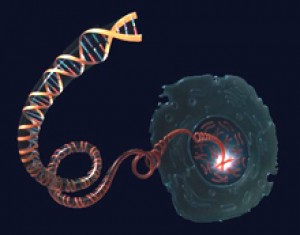New Insights Into Breast Cancer
New Insights Into Breast Cancer
A careful analysis of genomic data further defined 4 primary subtypes of breast cancer, each with its own biology and survival outlook. One subtype shares many genetic features with high-grade serous ovarian cancer. The findings may help to guide future treatment strategies.

Illustration courtesy of NHGRI.
Each year about 1.3 million new cases of breast cancer arise worldwide, contributing to about 450,000 deaths, according to the World Health Organization. It’s the most common cancer among women. Men can also develop breast cancer but account for a small fraction of cases. The majority of breast cancers are sporadic, meaning there is no family history of the disease. However, many genes can predispose a person to breast cancer.
For the new study, researchers performed a comprehensive genomic characterization of samples from 825 breast cancer patients. The extensive data were generated by The Cancer Genome Atlas (TCGA) Research Network, which consists of more than 150 researchers at dozens of institutions across the world. The study was a collaborative effort funded by NIH’s National Cancer Institute (NCI) and National Human Genome Research Institute (NHGRI). The results appeared on October 4, 2012, in Nature.
In addition to identifying nearly all the genes previously implicated in breast cancer, the researchers implicated several novel genes, includingTBX3, RUNX1, CBFB, AFF2, PIK3R1, PTPN22, PTPRD, NF1, SF3B1 andCCND3.
The scientists distinguished 4 main subtypes of breast cancer. Each subtype has its own biology and survival outlook. The 4 subtypes are called HER2-enriched (HER2E), Luminal A (LumA), Luminal B (LumB) and Basal-like.
The scientists found that the Basal-like subtype shares many genetic features with high-grade serous ovarian cancer, suggesting that the 2 cancers are of similar molecular origin. Serous ovarian cancer has proven difficult to treat. Computational analyses suggested compounds that might affect these cancers.
“The molecular similarity of one of the principal subtypes of breast cancer to that found in ovarian cancer gives us additional leverage to compare treatments and outcomes across these 2 cancers,” says NCI Director Dr. Harold Varmus. “This treasure trove of genetic information will need to be examined in great detail to identify how we can use it functionally and clinically.”
The broad scale of this study will lead to a deeper understanding of the changes essential for cancer progression. The researchers hope these discoveries will be a crucial step toward improving breast cancer therapies.
“The data generated by the TCGA program comprise a vast resource that investigators will be analyzing for years to come. The resource of information about breast cancer genomes will undoubtedly fuel myriad discoveries by the cancer research community,” says NHGRI Director Dr. Eric D. Green.
###
* The above story is reprinted from materials provided by National Institutes of Health (NIH)
** The National Institutes of Health (NIH) , a part of the U.S. Department of Health and Human Services, is the nation’s medical research agency—making important discoveries that improve health and save lives. The National Institutes of Health is made up of 27 different components called Institutes and Centers. Each has its own specific research agenda. All but three of these components receive their funding directly from Congress, and administrate their own budgets.



















